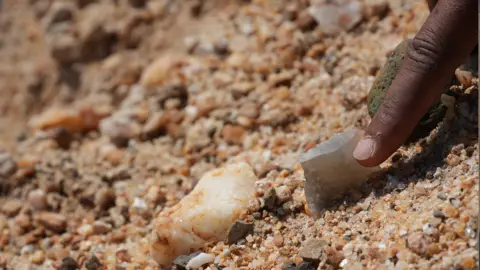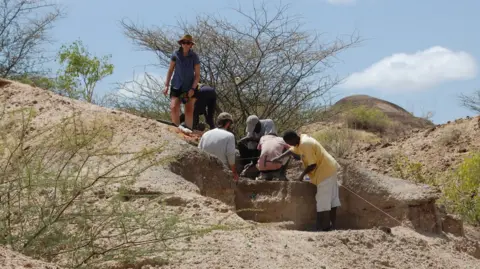
Pallab GhoshScience correspondent
 David Brown
David BrownThe earliest humans who lived millions of years ago may have been inventors, according to a discovery made in northwestern Kenya.
Researchers have discovered that early humans who lived 2.75 million years ago at an archaeological site called Namorotukunan continuously used stone tools for 300,000 years.
Previous evidence suggested that early human use of tools was sporadic: occurring by chance and quickly forgotten.
The Namorotukunan find is the first evidence that technology was passed down from generation to generation.
According to Professor David Brown of George Washington University in Washington, DC, who led the study, this finding: published in the journal Nature Communicationsprovides incredibly compelling evidence for a radical change in our understanding of human evolution.
“We thought tool use might have been a blip and then disappeared. When we see the same thing for 300,000 years, it's simply impossible,” he said.
“It’s a long-term continuity of behavior. This use of tools (by humans and human ancestors) probably occurred much earlier and over a longer period of time than we thought.”
 David Brown
David BrownArchaeologists spent ten years at Namorotukunan, uncovering 1,300 sharp flakes, chips and stone cores, each formed from carefully crafted stones collected from river beds. They are made using a technique known as Oldowan and are the first widespread method of making stone tools.
The same tools are presented in three separate layers. The deeper the layer, the further away the snapshot is in time. According to the research team's senior geologist, Dr Dan Palcu Rolier of the University of Sao Paulo in Brazil, many of the stones were specifically chosen for their quality, suggesting the producers were experienced and knew exactly what they were looking for.
“What we see here on the site is an incredible level of complexity,” he told BBC News.
“These guys were extremely astute geologists. They knew how to source the best raw materials and these stone tools are exceptional. In fact, we could cut our fingers with some of them.”
Geological evidence suggests that the use of tools likely helped these people survive dramatic climate changes.
The landscape changed from lush wetlands to dry, fire-torn grasslands and semi-deserts,” said Rahab N. Kinanjui, senior research fellow at the National Museums of Kenya.

These abrupt changes in the environment usually force animal populations to adapt through evolution or go away. But according to Dr. Palcu Rolier, instrument makers in the region have prospered by using technology rather than biological adaptation.
“Technology allowed these early East Turkana inhabitants to survive in a rapidly changing landscape—not by adapting themselves, but by adapting their ways of foraging.”
Evidence of stone tools in different layers shows that, over a long and continuous period, these primitive people went against biological evolution, finding a way to control the world around them, rather than allowing the world to control them.
And this happened at the very beginning of the emergence of humanity, according to Dr. Palku Rolier.
“Using tools meant they didn't have to evolve by modifying their bodies to adapt to these changes. Instead, they developed the technology they needed to gain access to food: tools for opening animal carcasses and digging up plants.”
 David Brown
David BrownThere is evidence at this site that animal bones were broken, cut with stone tools, meaning that due to these changes they were able to continually use meat as a means of subsistence.
“This technology gives these early inhabitants an advantage,” says Dr. Palku Rolier.
“They can access different types of food as the environment changes, their livelihood changes, but because they have this technology, they can bypass these problems and access new food.”
 David Brown
David BrownAround 2.75 million years ago, the region was inhabited by some of the earliest humans, who had relatively small brains. These early humans are thought to have lived alongside their evolutionary ancestors: a pre-human group called australopithecines, which had larger teeth and a mixture of chimpanzee and human features.
The tool users at Namorotukunan most likely belonged to one of these groups, and possibly both.
Professor Brown said the discovery challenges the view of many human evolution experts that chronic tool use arose much later, between 2.4 and 2.2 million years ago, when humans evolved relatively larger brains.
“The argument is that we are seeing a fairly significant increase in brain size. And so it is often argued that the use of tools allowed them to feed this large brain.
“But in Namorotukunan we see these really early tools being used before brain size increases.”
“We have probably greatly underestimated these early humans and their ancestors. In fact, we can trace the roots of our ability to adapt to change using technology much earlier than we thought, all the way back to 2.75 million years ago, and perhaps much earlier.”









